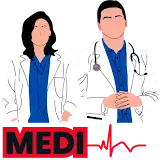Anatomy is the study of the structure of living organisms. It is a crucial field for medical professionals as it provides a foundation for understanding how the body works and how it responds to disease and injury. In this blog, we will provide an introduction to general anatomy, including the different types of tissue, organs, and systems in the human body. This blog is aimed at medical students who are starting their journey in the field of medicine.
Keywords: Anatomy, Human Body, Tissue, Organs, Systems, Medical Students.
Overview of General Anatomy: General anatomy is a branch of anatomy that deals with the structure of the human body at a macroscopic level. It covers everything from the basic building blocks of the body (cells) to the complex systems that work together to keep us alive. Here is a brief overview of some of the key concepts in general anatomy.
Cells: Cells are the basic building blocks of the human body. They are the smallest unit of life and are responsible for carrying out all of the functions necessary for survival.
Tissue: Tissue is a group of cells that work together to perform a specific function. There are four main types of tissue in the body: epithelial, connective, muscular, and nervous.
Organs: Organs are groups of tissues that work together to perform a specific function. For example, the heart is an organ that is made up of cardiac muscle tissue and is responsible for pumping blood throughout the body.
Systems: Systems are groups of organs that work together to perform a specific function. There are 11 major systems in the human body, including the cardiovascular system, respiratory system, and nervous system.
Anatomical position: Anatomical position is the standardized position used in anatomy to describe the location of structures in the body. It is a standing position with the arms at the sides and the palms facing forward.
Systems of the Human Body: Here is a brief overview of the 11 major systems in the human body:
Cardiovascular system: The cardiovascular system is responsible for pumping blood throughout the body, delivering oxygen and nutrients to cells and removing waste products.
Respiratory system: The respiratory system is responsible for breathing, which allows oxygen to enter the body and carbon dioxide to exit.
Digestive system: The digestive system is responsible for breaking down food and absorbing nutrients that are necessary for survival.
Urinary system: The urinary system is responsible for removing waste products from the body, including excess water and salts.
Endocrine system: The endocrine system is responsible for producing hormones that regulate various bodily functions.
Nervous system: The nervous system is responsible for controlling and coordinating the body's responses to internal and external stimuli.
Muscular system: The muscular system is responsible for movement and support of the body.
Skeletal system: The skeletal system provides support and protection for the body, as well as a framework for muscle attachment.
Integumentary system: The integumentary system is responsible for protecting the body from external damage and regulating body temperature.
Immune system: The immune system is responsible for defending the body against foreign invaders, such as viruses and bacteria.
Reproductive system: The reproductive system is responsible for producing and delivering gametes (sperm and eggs) for fertilization, as well as supporting the development of a fetus during pregnancy.
Conclusion: In conclusion, general anatomy is a crucial field for medical professionals. By understanding the structure of the human body at a macroscopic level, medical students can gain a foundation for understanding how the body works.
